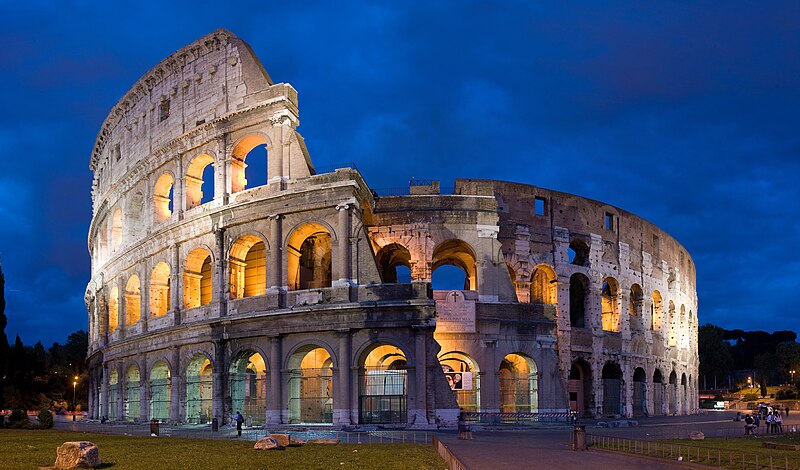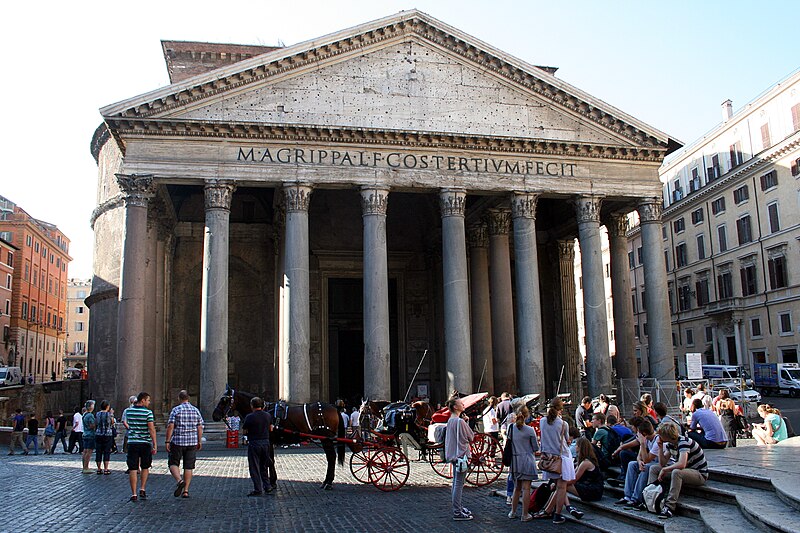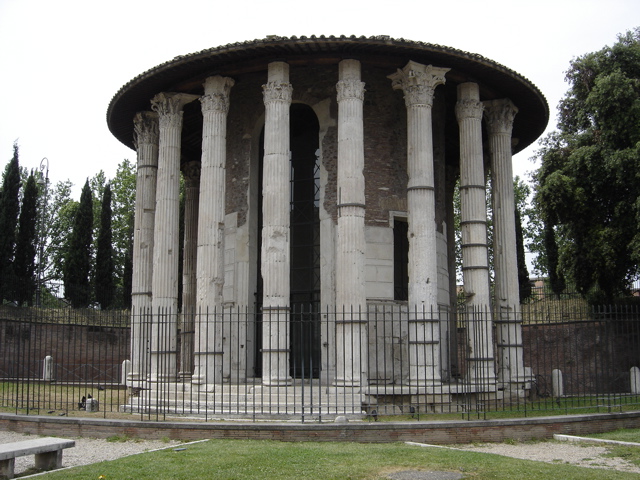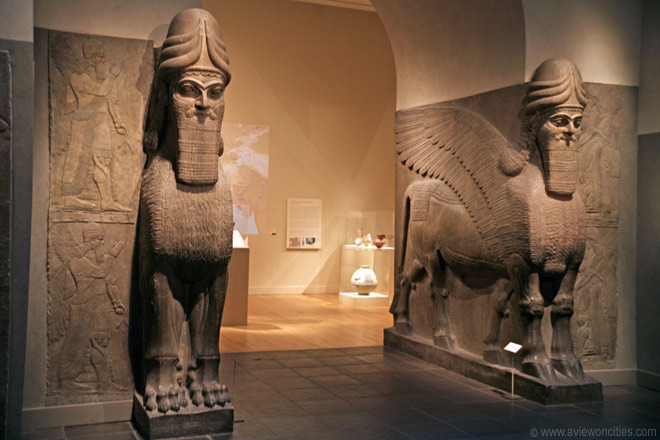Religion
Related: About this forumWhat happened to the Greek and Roman temples and religious statuary?
The Colosseum might provide a bit of clue: it remains there only because of its massive size, having been used for various purposes over the centuries, having been damaged in earthquakes, and having been quarried for its bronze fittings and stone

Some other buildings survived better.
The Parthenon in Athens remained a usable building until the seventeenth century, when

The Parthenon once housed a giant statue:
As the accusation against Phidias shows, such a large expensive statue might have posed a certain temptation to looters
The Pantheon is still in relatively good condition in Rome today:

The Temple of Hercules is today the oldest marble building in Rome; it was used as a church (Santo Stefano alle Carozze) from the twelfth century

What of the ancient god-images such temples once held?
Love of bronze was very old; the Zeus of Cape Artemisium dates to about 500 BCE

Bronze had the advantage of high strength, compared to (say) terra cotta or marble. The hypothesis that many such statues might have been melted down seems credible, since we have many reports throughout history of the reuse of bronze monuments. Pliny, for example, says the Athenians melted down three hundred statues of Demetrios of Phaleron; it has been estimated that half of the public monuments in Paris were melted down for ammunition during the Vichy years; and the bronze plaques on the WWI memorial in Chicago's Pullen Park were removed during WWII to provide metal for the war effort. Back in 2005, a two tonne Henry Moore bronze was stolen and apparently melted down as scrap:

Cartoonist
(7,317 posts)between Samson and Hercules?
edhopper
(33,580 posts)I'd say Hercules.
What about between Jesus and Superman.
For the simple reason that he could transubstantiate anything handy into Kryptonite.
Superman wouldn't stand a chance, IMHO.
Just my two cents.
beam me up scottie
(57,349 posts)bvf
(6,604 posts)for the resident scholars to weigh in on that.
beam me up scottie
(57,349 posts)I learn so much here.
![]()
edhopper
(33,580 posts)And not bringing him into our life.
beam me up scottie
(57,349 posts)I wouldn't mind seeing The Doctor thrown into the mix.
edhopper
(33,580 posts)St. Thomas Aquinas
beam me up scottie
(57,349 posts)I’m the Doctor. I’m a Time Lord. I’m from the planet Gallifrey in the constellation of Kasterborous. I’m 903 years old, and I’m the man who’s gonna save your lives and all six billion people on the planet below. You got a problem with that?
stillwaiting
(3,795 posts)They are Anti-Christ, and they would eagerly kill him again if he came back saying the same things he did the first go round.
awoke_in_2003
(34,582 posts)
LostOne4Ever
(9,289 posts)
struggle4progress
(118,285 posts)LostOne4Ever
(9,289 posts)I decided it's not necessary to suffer and feel crappy just because my teams suck. What I do now is cut 'em loose for awhile. I simply let them go about losing, as I go about living my life. Then, when they've improved, and are doing well once again, I get back on board and enjoy their success. Yeah, I know, I can hear it: diehard, asshole loyal sports fans screaming, "Front-runner!" Goddamn right! Don't be fuckin' juvenile. Teams are supposed to provide pleasure and entertainment, not depression and disappointment.
It is also completely unnecessary to suffer several days' emotional devastation just because your team loses some big postseason deal like the Super Bowl. Why on earth would you place your happiness and peace of mind in the hands of several dozen strangers? Listen, folks, if they win, fine; if they lose, fuck 'em! Let 'em practice more. As for you, for Chrissakes find something to do! Get your ass down to the massage parlor and spring for a blow job.
If you really want to enjoy sports, do what I did. Become a Harlem Globetrotters fan. There's no losing, no stats, no strikes, no trades, no contract hassles, no postseason, and no annoying media. Just winning, all the time, every night. By the way, I'm diseased enough to root for the Washington Generals, the team that loses to the Globetrotters every night. At least you wouldn't have to put up with all that annoying, preseason optimism bullshit.
[font style="font-family:'Georgia','Baskerville Old Face','Helvetica',fantasy;" size=4 color=teal]-George Carlin[/font]
rug
(82,333 posts)I was fortunate enough to hear Pete Seeger sing this in concert. And a friend who's both a musician and an IWW organizer belts it out pretty fair, too.
AtheistCrusader
(33,982 posts)edhopper
(33,580 posts)Can Jesus transubstantiate anything but food?
bvf
(6,604 posts)is keep a herring with him at all times. No religious scholar I'm aware of has addressed this one way or the other.
edhopper
(33,580 posts)Attack him from afar. And Jesus is vulnerable at his wrists and feet.
bvf
(6,604 posts)In the interest of full disclosure, I haven't read enough of Aquinas (or Shuster and Siegel, for that matter) to have a good answer.
edhopper
(33,580 posts)Superman is capable of whatever the writers want him to be.
awoke_in_2003
(34,582 posts)"All is said it "that halibut is good enough for Jehovah'"
Jim Lane
(11,175 posts)He caused a fig tree to wither when it displeased him, right? (I think its "sin" was not bearing fruit in the middle of winter, but whatever.) That indicates that Jesus has some sort of destructive power over living organisms.
And don't tell me that Superman is invulnerable. It was stated numerous times in the comics that Superman can be affected by magic.
bvf
(6,604 posts)and over a billion people congratulating him for that...
Words fail me.
Was Mr. Mxyzptlk involved in any of that magic monkeybusiness, or was that purely an extra-dimensional sort of thing? I forget.
Jim Lane
(11,175 posts)The Wikipedia article about the imp states:
That explains my reaction -- I was a comics reader during the Silver Age. Apparently, however, that isn't firmly canonical. The Wikipedia article also states, "Mr. Mxyzptlk has access to fifth-dimensional technology that appears to be magical to third-dimensional beings." A later sentence in that paragraph deploys scare quotes around the word:
I conclude that this is another difficult issue, a challenge for scholars right up there with your question about Jesus and the halibut.
By the way, everyone who has posted in this subthread is going to Hell.
Cartoonist
(7,317 posts)was used as a church. I bet if there was a Temple of Samson, it would be a barber shop now.
edhopper
(33,580 posts)into churches.
Probably the only thing that saved them.
Warren Stupidity
(48,181 posts)struggle4progress
(118,285 posts)http://www.newadvent.org/fathers/27025.htm
Warren Stupidity
(48,181 posts)struggle4progress
(118,285 posts)an honorary appointment. His later years (from 354 CE onward) were spent at Antioch
Edessa was sacked by Trajan, Caracalla was later assassinated there, and the town was ravaged by a great flood in 201 CE. The Sassanids defeated and captured the Roman army there in 260 CE. This seems to have been a border region between the Roman and Sassanid empires. The Chronicle of Edessa reports that in "the year 614 <that is, c. 300 CE>, were broken down the walls of Edessa the second time in the days of Diocletian the king"
After becoming emperor in the early 6th century, Justin rebuilt the city and named it after himself.
Here's a link Libanius's Oration 30 (Pro templis), in the form of a letter to Theodosius
This oration is almost entirely rhetorical
Warren Stupidity
(48,181 posts)Warren Stupidity
(48,181 posts)struggle4progress
(118,285 posts)On July 21, 356 B.C.E., a man named Herostratus deliberately set fire to the Temple of Artemis at Ephesus ... When the people of Ephesus saw the smoking ruins of the temple, Herostratus made certain they knew that he was the guy responsible. The motive behind Herostratus’ seemingly senseless act of arson was recorded by the historian Valerius Maximus, “so that through the destruction of this most beautiful building his name might be spread through the whole world” ...
In the so-called Acts of John (from the 2nd or 3rd century CE), a certain John prayed the temple to destruction:
... John said: Let us first go unto the temple of Artemis, for perchance there also, if we show ourselves, the servants of the Lord will be found ... And John said to them: If then ye desire not to die, let that which ye worship be confounded, and wherefore it is confounded, that ye also may depart from your ancient error. For now is it time that either ye be converted by my God, or I myself die by your goddess; for I will pray in your presence and entreat my God that mercy be shown unto you. And having so said he prayed thus: O God that art God above all that are called gods, that until this day hast been set at nought in the city of the Ephesians; that didst put into my mind to come into this place, whereof I never thought; that dost convict every manner of worship by turning men unto thee; at whose name every idol fleeth and every evil spirit and every unclean power; now also by the flight of the evil spirit here at thy name, even of him that deceiveth this great multitude, show thou thy mercy in this place, for they have been made to err. And as John spake these things, immediately the altar of Artemis was parted into many pieces, and all the things that were dedicated in the temple fell, and ... was rent asunder, and likewise of the images of the gods more than seven. And the half of the temple fell down ...
Here, however, is a different view:
The Temple of Artemis at Ephesus was one of the Seven Wonders of the Ancient World but almost nothing is left of it today. So, the question of who destroyed it is an interesting one. Luckily, we have an explicit historical source that tells us the answer. It is in Jordanes’ History of the Goths composed around 550AD. He tells us (20:107), that in about 259AD, “Respa, Veduc and Thuruar, leaders of the Goths, took ship and sailed across the strait of the Hellespont to Asia. There they laid waste many populous cities and set fire to the renowned temple of Diana at Ephesus, which, as we said before, the Amazons built.” Jordanes’ work comes with a health warning because the beginning is pure legend (not to mention his claim that the Amazons built the Temple). However, it is generally felt to be reliable when it deals with encounters between the Goths and Romans from the third century AD. After the Goths destroyed the Temple of Artemis, it was quarried by the local inhabitants for its valuable marble and very little is left today. Bits of it have been found in local buildings and Justinian took much of the statuary that survived to his time back to Constantinople. So why is the destruction of this Temple blamed on Christians? ... The source of this legend is the Acts of John. This is a very late and inauthentic apocryphal book that claims to tell the life story of St John the Apostle ... The Acts of John is normally dated to the third century and the inclusion of this episode in all likelihood means that it was written after the Temple had actually been burnt down by the Goths (who were, at this stage, still pagans). But the Acts do provide further evidence that the Temple really was destroyed during the third century. We can be absolutely certain it was not pulled down on the orders of St John around 100AD as the Acts pretends.
Warren Stupidity
(48,181 posts)brooklynite
(94,581 posts)
Hittite Lion -- Syria (outside Aleppo) -- 5,000 years old
(we saw this on our visit, two weeks before the uprising started. Fortunately ISIS doesn't seem to have found it)
littlemissmartypants
(22,667 posts)Thanks for posting.
~ lmsp ![]()
edhopper
(33,580 posts)I have never been to Iraq, but there are some good Assyrian artifacts at the Met Museum in NY. Including a large gate.
It breaks my heart thinking about the destruction these monsters are doing in the name of their religion.
[img] [/img]
[/img]
okasha
(11,573 posts)s4p
bvf
(6,604 posts)That should be obvious by now.
cbayer
(146,218 posts)advent of christianity. The Parthenon is the most amazing example. The Temple of Minerva in Assisi is another amazing building. One can not avoid being enraptured by the history of some of these buildings.

struggle4progress
(118,285 posts)both of which were punishable by death. In 380, under the emperor Theodosius, Christianity became the state religion. In 435, Theodosius II ordered the sign of the cross to be put everywhere. The pagan cult was brought to an end and the Temple of Minerva remained abandoned and silent for over a century ... The precise date is not known, but probably in the second half of the sixth century, the Benedictine monks restored the temple and made use of it. The divided the cella into two floors, creating living rooms in the upper part and the church of “San Donato” in the lower part ... With the act of May 24, 1212, for one hundred years, with the option of renewal, the Benedictines leased the temple to the Comune of Assisi ... It should be noted that in the time from 1200 to 1300 the pronao functioned as the Tribunal court and the little church of “San Donato” was used as the municipal jail at least until the beginning of the fifteenth century ... In the years 1527-1530, the magistrates of Assisi, following requests and complaints by the citizens, ordered some urgent restoration projects to be undertaken. In 1539, Pope Paolo III, making a visit to Assisi, ordered the Temple of Minerva to be completely restored and dedicated to the Virgin Mary, queen of true wisdom. The temple then took the name of “Santa Maria sopra Minerva” ... http://www.franciscanum.it/en/temple-of-minerva/
I think "Costanzo" here means "Constantius II." Three brothers (Constantine II, Constantius II, and Constans) co-ruled briefly following the death of their father Constantine I in 337 CE -- but they had a falling out around 340 CE, leading to a split of the territories and protracted warfare. Constantine II died in a failed invasion of Italy in 340 CE. Constans was assassinated in 350 by members of his guard loyal to Magnentius, who had declared himself emperor. In this context, anti-pagan edicts from Constantine II or Constantius II might reasonably be understood as political moves, intended to consolidate support.
Theodosius II became Byzantine co-emperor in 402 CE and ruled as emperor 408 - 450 CE. Valentian was simultaneously Western emperor 425 - 555 CE, when he was assassinated and Petronius Maximus declared himself emperor, ruling for two months: a Roman mob stoned Petronius Maximus to death only three days before the Vandals under Geiseric captured and sacked Rome. The Theodosian Code was promulgated in 439 CE. The empire was collapsing at this time. The Visigoths had already sacked Rome in 410. Geiseric broke the treaty between the Vandals and Rome in 439.
cbayer
(146,218 posts)What I loved was how they had preserved some elements of the temples.
The Parthenon was probably the most interesting building I have ever been in.